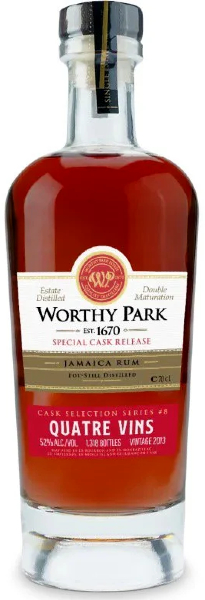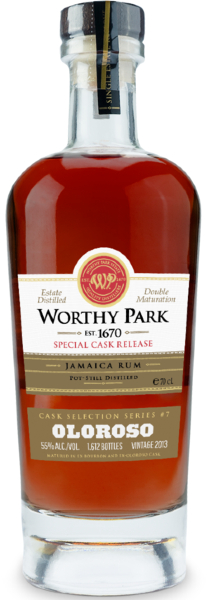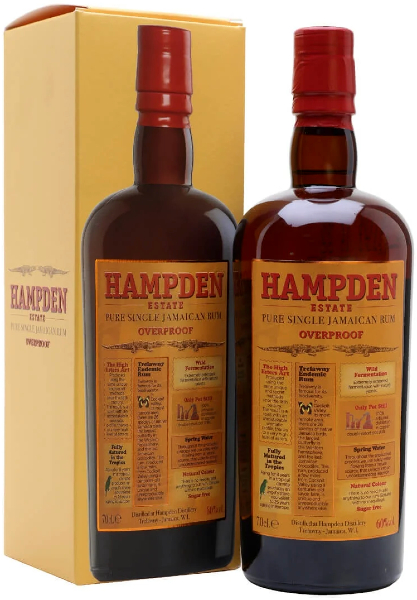As we saw in the previous review, Worthy Park, as it is now, is a relatively new distillery, with the first distillate running off the still in 2007. As we all know, new distilleries sell a lot of young stuff, so there are a lot of rather young independent bottlings to be found, as well as a lot of the releases of the distillery itself are quite young, like most of these Cask Selection Series. By now, there is our Single Estate Reserve as well as a few 10yo’s (again finishes like the Madeira and the Port, both bottled @ 45% ABV.) and a 12yo bottled @ 56% ABV. So, since the distillery isn’t operational for all that long, it simply doesn’t have older stuff to release. A new distillery has to reach a lot of people to get some of the invested money back quickly to survive, so a distillery like this won’t be going for an extreme and funky style (yet). Non of the Worthy Parks I have tried until now, came across as a high ester Rum in taste (and nose). So for a Jamaican Rum, Worthy Park isn’t about all that super high ester stuff, like we saw with Hampden (or Long Pond).
By the way, Monbazillac, Sauternes, Moscatel & Jurançon are all sweet White Wines. Moscatel is fortified and Jurançon exists also in a dry version as well but then it is called Jurançon-Sec. However, I don’t think they used the dry variant here, since the rest is Sweet, but you can never be sure now can you. Since the previous review and the one below are from the Cask Selection Series, here is a list of the eight releases I know of:
Worthy Park 2012 Marsala Cask Selection Series #1 for La Maison Du Whisky, France, 60%, 319 bottles, 2017
Worthy Park 2012 Oloroso Cask Selection Series #2, 59%, 428 bottles, 2017
Worthy Park 2013 Sherry Cask Selection Series #3, 57%, 1.148 bottles, 2018
Worthy Park 2013 Madeira Cask Selection Series #4, 58%, 677 bottles, 2018
Worthy Park 2008 Port Cask Selection Series #5, 56%, 585 bottles, 2018
Worthy Park 2013 Virgin Cask Selection Series #6 for The Nectar, Belgium, 55% 342 bottles 2019?
Worthy Park 2013 Oloroso Cask Selection Series #7, 55%, 1.612 bottles, 2019
Worthy Park 2013 Quatre Vins Cask Selection Series #8, 52%, 1.318 bottles, 2019
 Color: Orange brown.
Color: Orange brown.
Nose: This one starts with a nice funky caramel, like Jamaican funk toffee (if it exists). Clay, fatty and creamy. Honey, nutty, unlit tobacco, slightly burnt toast and warm plastic or polyester even. Organic and slightly grassy. Paint with a hint of solvents and vinegar made from Wine. Chocolate Rum beans. Spicy and obviously a bit winey yet also meaty. Gravy, dry and dusty. Nice fresh oak, in part a bit like plywood. Hints of Alsatian Gewürztraminer, but also the flinty bit of a Pouilly Fumé. Both wines, strangely enough, not one of the Quatre Vins. A fast flowing gutter in the rain. What? Yeah, well, the Wines give this Rum a bit of a combined note that is hard to put into words. Red fruit candy without the sweetness. Dusty, as well as some mocha and vanilla powder. Do you remember the smell of a bowl that had vanilla ice-cream in it a few hours ago? So, from this big funky start it first turns fruity and next, more dry and spicy. A lot of the complex initial smells wear off a bit. Stock cube, with hints of toasted oak and licorice. The development is not all that dissimilar to the previously reviewed Oloroso version. No doubt about it, this is a very good quality Rum, yet again, lacking a bit of the Jamaican funk, I’ve come to expect from a Jamaican Rum. It is almost closer to, yet another, rather new, high quality Rum that is Foursquare from Barbados, than to its Jamaican brother from another mother, Hampden. Traits I’m actually looking for in a Jamaican Rum. When you have a few open bottles of Rum around, like me, sometimes you feel like having a nice Rhum Agricole from Martinique, Guadeloupe, or Reunion. On other occasions, Jamaican Funk or a nice Demerara is the way to go. Worthy Park is very good Rum, but it isn’t old skool Jamaican in style. Jamaican funk without the funk is like chicken without the jerk, but I may have mentioned something like this as well about the Oloroso bottling. So sometimes when I want to go Jamaican, I tend to go for something like Hampden or Long Pond, more outspoken and yes, sometimes hit or miss, like the Hampden from Cadenhead I just reviewed. That one is just strange (in a good way), but therefore not for everybody/anyone. Apart from the nose not being quintessentially Jamaican, it definitely is a rather good nose though, lots happening and very fine. I have to say the Wines do lift this nose beyond the nose of the Oloroso version, the Quatre Vins smells rather exciting, and in comparison, the Oloroso can smell young and unfinished.
Taste: Big, fatty and sweet at first, yet quickly (in a millisecond or so) turning dry, spicy and winey. Although more of the Red Wine kind, than Sweet Whites (because of the sour notes). Herbal, medium bitter, green and somewhat hot. Flinty and with a slightly burnt edge to it. Licorice upfront as well as some bicycle inner tube rubber seems to be associated with it. Warming. Maybe slightly Jamaican in the beginning, but not really actually during the rest of the experience. As I said, short lived. Wax and almonds. All those different casks got very busy, but here in a somewhat disharmonious way. For me, it worked a lot better in the nose. Just like the Oloroso version, it thus starts big, funky and fatty, and it turns more dry, austere, herbal and spicy, rather quickly, which might seem odd. People tend to believe Rum is a sweet distillate, since is it closely associated with sugar as well as the fact that this has been finished in casks that previously held Sweet Wines, so one would expect something sweeter than this. Hints of latex paint. Where the Wine-casks helped the nose past the Oloroso, here on the palate, the Oloroso clearly worked better. Which is a shame really, because the nose of the Quatre Vins is much better. Well, one supposedly can’t have it all. In the finish, obvious notes of slightly milky, Red Wine notes, Merlot, this time and again not one of the Quatre Vins, and yet another Red, how peculiar. Hints of toasted oak, European oak, spicy and tannic. The finish, with some plastic/polyester and bitter notes, is short and quickly moves into the aftertaste. Which is unbalanced, actually it falls apart into a woody (bitter) bit and an acidic, winey bit, making this one somewhat less tasty to drink. Still a shame really, since the nose is really good and interesting as well.
First of all, if you want old skool Jamaican funk, than maybe you should reconsider buying a Worthy Park just yet. Do you want to buy a good Rum, than Worthy Park is happy to oblige, why not, it can be, and usually is good stuff, even though this Quatre Vins is something of an strange beast. Which one to get is up to you. Between the two, the Oloroso version is better and easier to get through, although somewhat sweeter (and more of the burnt notes) and with a (slightly) less interesting nose than this Quatre Vins offering. This one in particular is let down a bit by the taste, with the Wine casks playing a dubious role, and definitely overpowering the Ex-Bourbon cask maturation.
Points: 81
 Color: Orange brown.
Color: Orange brown. Color: Light gold.
Color: Light gold. Color: Orange gold.
Color: Orange gold. Color: Gold.
Color: Gold.
 Color: Copper orange.
Color: Copper orange. Color: Light gold.
Color: Light gold.
 Color: orange Brown.
Color: orange Brown.